Survival Bootcamp

'Survival Bootcamp (Michael Hanson)'
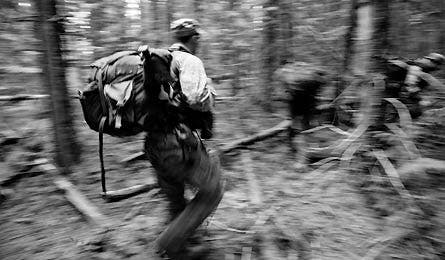
Survival Bootcamp (Michael Hanson)
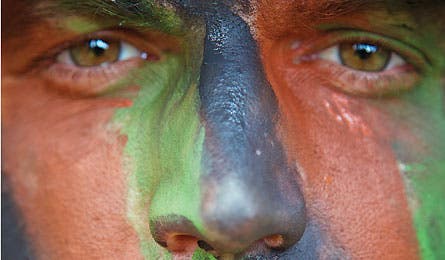
Concealing Themselves (Michael Hanson)

Edible Plants (Michael Hanson)
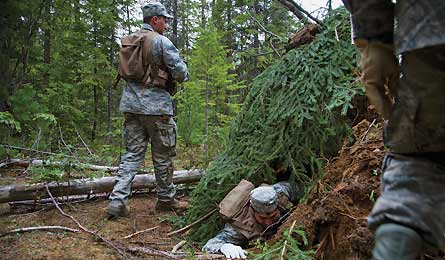
Rootball and Branch Shelter (Michael Hanson)
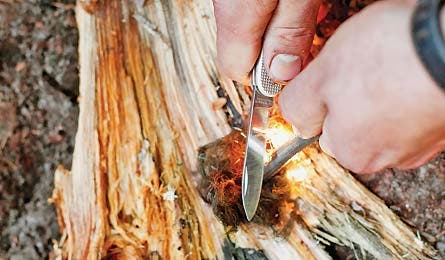
Magnesium Started Fire (Michael Hanson)
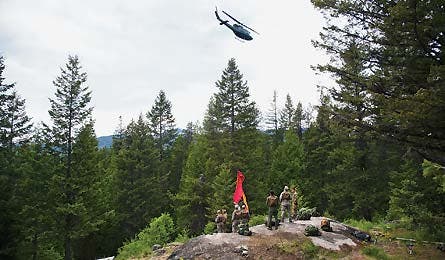
Rescue Helicopter (Michael Hanson)
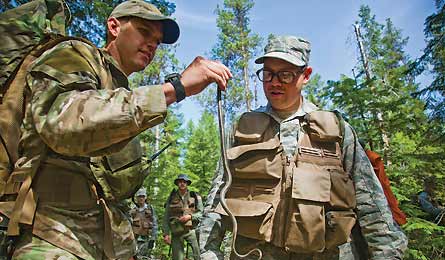
Killing and Skinning a Snake (Michael Hanson)
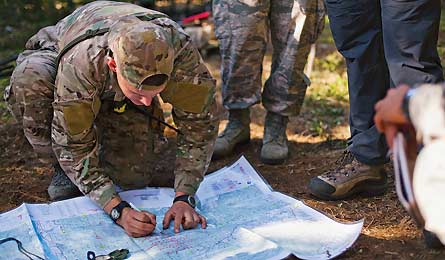
Plotting Day’s Movement (Michael Hanson)
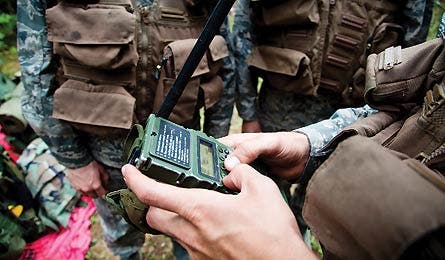
Calling in for Help (Michael Hanson)
Late last summer, more than two years after he was captured by militants in Afghanistan, U.S. Army Sergeant Bowe Bergdahl escaped.
Over time, he had earned his captors’ trust enough to sleep without restraints, and near the end of August 2011, America’s only current prisoner of war made his move. He leaped from a first floor window in the mud-brick house where he’d been held in northwestern Pakistan and raced into the rugged, wooded mountains.
He was lightly clothed and without food or water. The fighters holding him set out in pursuit. They knew the territory; Bergdahl did not. Still, he stayed on the run, eluding his pursuers as he tried desperately to determine a way to escape the enemy’s stronghold.
The details of Bergdahl’s escape attempt are murky, and the military has been tight-lipped about what it knows. But according to Taliban fighters interviewed by journalists, the 26-year-old from Sun Valley, Idaho, hoped to find a civilian who would show mercy and help him contact U.S. forces in Afghanistan. Unknown to Bergdahl, most of the civilians had long ago fled the area because of constant fighting. Anyone he came across would likely help his hunters.
On the third day of the chase, Bergdahl sought refuge in a shallow ditch he’d dug with his bare hands. He lay down in the depression and covered himself with leaves. It wasn’t enough. The Taliban found him there, weak and dehydrated. Bergdahl tried to fight off his captors, but they subdued him.
As an Army infantryman, he’d been taught to march and shoot a rifle and pitch hand grenades, but he hadn’t learned the tricks and skills of escape and survival.
“Had he had this training, would he have been successful?” Senior Master Sergeant Jerry Nowlin asks from the auditorium stage at Fairchild Air Force Base outside of Spokane, Washington. Packed in the seats before him are 92 students on their first day of SERE school—Survival, Evasion, Resistance, and Escape.
Over the next 19 days, Nowlin tells them, they’ll learn how to handle themselves in just this type of situation. Before stepping off the stage, he offers an ominous prediction, delivered with a smile: “You’re going to get wet. You’re going to get hungry. You’re going to get tired.” He doesn’t need to add: You’re not going to be Sgt. Bergdahl.
SERE training is required for those deemed at high risk of isolation or capture, mostly pilots and aircrews who could find themselves deep within enemy-held territory. “The government has pumped millions of dollars into training these guys to do their jobs,” Nowlin tells me later. “This is an extended warranty.” He wants students to have the practical and mental skills to survive five weeks on the run in the wilderness, and an indefinite time in captivity.
The Air Force survival training started after World War II, in Alaska, and was originally focused on wilderness skills. But after the Korean War, when captured soldiers were interrogated and sometimes swayed by the enemy, the military introduced the Code of Conduct, which outlines service members’ responsibility to resist by all means necessary and never surrender or betray themselves, their comrades, or their country.
The Code is summed up in the SERE school motto, “Return with Honor.” The school’s method: inoculation. Expose students to a little stress now and teach them core skills so if they encounter the real thing, they won’t freak out, whether it’s being cold in the woods or beaten as a captive.
I’m here to learn how that inoculation works. I spent a few years as an Army infantryman, which included two tours in Iraq, and I’ve hiked and camped around the world, so I have a foundation of outdoor and survival skills. But I wanted to learn the most effective, most efficient methods for staying alive anywhere—and in conditions where cold and hunger aren’t your only worries. For that, nothing compares to SERE.
The Air Force let me enroll with a caveat: I couldn’t observe the final week of training—resistance and escape—which is secret, and I couldn’t write about some of the signaling techniques we’d use to alert rescue crews, again because that could presumably endanger soldiers in real-world scenarios. And even though this is training, the real world is never far away. When we’re divided into small groups for field-based training, my classmates include First Lieutenant Blake Brooks, who will soon be flying small reconnaissance planes in some of the world’s most dangerous areas. He knows if his plane goes down, he and his crew could be hundreds of miles from friendly forces.
There’s Airman Daniel Hernandez, who will run the surveillance equipment on those planes. And Sgt. Seth Rhow, an airborne linguist who will monitor conversations from several miles up. In a few months, they could be flying anywhere in the world. But consider just Afghanistan, a likely destination: After a crash landing, they could be on the run in the desert, amid snowy peaks, or in thick forest. They could be on the run in places that look just like the area in which Sgt. Bergdahl remains a captive of the Taliban today.
The school’s first phase is classroom instruction, and like most military training it’s done with PowerPoint and plenty of acronyms, like COLDER: Keep yourself and your equipment clean; avoid overheating; wear loose layers; stay dry; examine and repair your equipment. After mornings in class, we spend afternoons with an instructor who coaches small teams in hands-on skills.
With Airman First Class Casey Blackmon we read maps, sew a piece of parachute into a sleeping bag, sharpen knives, and tie knots. Much of this is basic, and that’s the point. Most outdoor enthusiasts have built their knowledge base over years of trips. But while some students here are competent woodsmen, others have never walked through a forest, so we move in small steps from fundamental to advanced skills.
Blackmon and the other instructors (known as SERE specialists) underwent rigorous training themselves, and they tell us their own stories of misery—tongues swelling and eyeballs shrinking from dehydration in the desert, skinning rabbits frozen solid by -50°F days in Alaska, puking from seasickness while riding ocean waves in rubber life rafts—ordeals they endured just to become SERE instructors.
But they mostly lace their lesson plans with real-life tales, like Capt. Scott O’Grady, who was shot down in his F-16C over Bosnia in 1995, dodged search teams for six days, drank rainwater sopped up and wrung from his socks, and ate bugs and worms—all skills he learned at SERE—before being rescued. And Japanese Lt. Hiroo Onoda, who spent 30 years hiding in the Philippine jungle.
Believing World War II hadn’t ended, he refused to surrender. In 1974, when his former commander traveled from Japan to bring him home, Onoda still had a uniform, a fully functional rifle, 500 rounds of ammunition, and five working hand grenades.
With a few exceptions, Lt. Onoda would recognize much of our field gear, as the military’s basic survival equipment hasn’t changed much. At the supply warehouse, we draw metal-framed backpacks, two ponchos, a thick cotton field jacket, two square three-quart canteens, a synthetic sleeping bag, and—a nod to more modern materials—a Gore-Tex bivy sack. We’ll also wear vests loaded with pockets, which hold small but important items: knife, lensatic compass, signal mirror, radio, and a topo map of the area.
But to use this survival gear, you must avoid capture. So on the last day before heading into the mountains, we crowd into the gym, where thick mats cover the basketball court, for “apprehension avoidance” training. For my classmates, most of whom trained for jobs that will keep them thousands of feet above the violence, this is a stark reminder of the harrowing situations they could face.
We divide into pairs and with our partner holding a thick pad, we practice strikes with the heel of our palms—think here of how a chimpanzee fights, not with a boxer’s punch, but wailing with the bottom of the fists, because it’s hard to build a fire or shelter with broken knuckles.
As I throw elbows and knees, and practice head butts and choke holds, it occurs to me: This could quite likely be a fight to the death, because even if an opponent has a broken arm, or is temporarily knocked unconscious, he could still alert others. There is no sport here. This is expedient and brutal, and the combatives training I did as an Army infantryman seems tame by comparison. Thumbs into the eyes near the nose, scooping out to the sides. Punches to the groin. “You should be a dirty fighter,” says Senior Airman Emory Corwine. “The intention of everything you do is to hurt him. You’re trying to get away.”
One of the militants interviewed after Bergdahl’s attempted escape told journalists Bergdahl fought fiercely, like a boxer, and that it took five men to subdue him. He had only his fists. Perhaps today’s training—or a weapon—could have helped. Corwine pulls out a box of makeshift weapons, quite possibly the only thing available to someone on the run. Rope to strangle, a sharpened stick to stab, a bag of rocks to clobber.
“Most improvised weapons will kill someone,” Corwine says. “They just won’t kill him fast enough.” Even knives can be too slow; in the minute or more it takes someone to bleed out, he can still fight. Corwine’s preferred weapon in a life-and-death fight? He suggests a pipe—or sturdy log in the forest—for a strike to the back of the head.
For the last half hour, we move through stations, practicing everything we’ve learned—strikes, takedowns, chokeholds. I’ll be going to the woods with a few bruises and strains.
On our first night in the field, after Blackmon makes a shelter in the upended rootball of a toppled Douglas fir, we set snares throughout a clearing: simple traps of thin copper wire that tighten around an animal’s neck when it runs through the loop. We’re hoping for a squirrel to supplement the MRE (Meal, Ready to Eat) and small assortment of snacks and energy bars we’ve each been given, the equivalent of about one meal per day.
The snares are still empty the next morning; this sort of hunting takes time, patience, and many snares placed in well-scouted locations, near food and water sources or the entrances to nests or burrows. A pilot on the run could also snatch the occasional rabbit or chicken from a farmhouse. But even without small game, there is plenty of food in the forest, if you know where to look.
As we walk through the Kaniksu National Forest, an hour north of Spokane, Blackmon and Senior Airman Brett Charity, another SERE instructor, continuously point out edible plants: trillium, young ferns, wild ginger, Grand Fir needles—which taste like pink grapefruit—huckleberries, and Oregon grape.
Charity hands a large black ant to Airman Thomas Stone, a C-130 loadmaster from Miami who has never spent the night in the woods. Charity tells him to eat it, and preferably with his front teeth, which will prevent it from biting his lip or crawling around in his mouth.
Stone pauses and considers the creature wriggling between his thumb and index finger, then slips it into his mouth.
“Tastes like lemon drops, doesn’t it?” Charity says.
Stone nibbles and ponders. His face shows surprise. “Yeah!”
Later, Airman Bill Heebsh, another C-130 loadmaster, catches an 18-inch garter snake. Charity presses it to a log and slices off its head. Were it poisonous, he’d cut an inch or two back, to avoid the venom sacks. He grabs the meat in one hand, the skin in the other, and yanks down, which pulls out all the organs. He drops the skinned snake, ready for cooking, into a plastic bag.
That evening, as mosquitoes swarm us by the score, we each practice making fires using petroleum jelly-soaked cotton balls and the brittle bottom branches of conifers. Blackmon disappears down a dirt road to a resupply site and returns with a clucking chicken under one arm and a squirming gray rabbit under the other.
“You’re killing him,” Blackmon tells me, after learning I’ve never slaughtered an animal. Per his instructions, I grab the rabbit by the back legs and hold it upside down. With a forearm-size piece of wood, I stroke its back, from tail to neck, which calms it. I swing the club, smashing the neck just behind the ears, which brings a dull crunch. The rabbit’s legs twitch with a few post-mortem convulsions.
Blackmon hangs him upside down on parachute cord strung between two trees, makes slits on the legs and belly, and pulls the skin down in one motion. He cuts off the head and pulls it back through the skin, so the rabbit now resembles a sock puppet. Blackmon slices open the abdomen, saves the heart, kidneys, and liver, and puts the rest of the entrails and the feet into the bag of skin.
In easy, swift motions, he butchers the rabbit into several neat pieces, which now look like they should be under cellophane at the meat counter. Easy as that. Like the other skills taught here, I find this incredibly effective training, demystifying a process that could save these men’s lives.
Blackmon demonstrates how to kill, skin, and butcher the chicken, and we’re soon loading large tin cans and packets of foil with chunks of rabbit and chicken, carrot and potato slices, and handfuls of trillium, which tastes something like bok choy when cooked. Belly full, I sleep in a one-man shelter made from a 10-foot sapling, bent over and tied to a log and stripped of its branches, with a poncho thrown over the top and the corner grommets staked.
The next night, after a day of lessons on camouflage, fire building, and more navigation, Blackmon gathers us in a clearing near our new camp. “We need to talk about psychological stressors,” he says. “What emotions have you guys been feeling out here?”
“Those mosquitoes really had me down,” Heebsh says. “And I’m not used to the diet. I’ve been trying to ration my food and that was catching up with me. I felt low on motivation.”
Blackmon nods, and offers advice: You’ll survive longer if you can tolerate discomfort and overcome aversions, like eating insects and worms, which provide much-needed nourishment. Keep the mind and body active—one POW in Vietnam built mental houses, from the foundation up, nail by nail, while in solitary confinement. Don’t dwell on self-pity, set realistic goals, and take a moment to relax.
“What we’re going to do right now,” Blackmon says, “is play some baseball.” With an alder branch for a bat, a duct-tape ball, and scuffed-up patches of dirt for bases, we spend the next half hour running and laughing, and it seems very much like a camping trip.
Then we’re on the move again. By 11 p.m., after 16 hours of motion, ending with a stumbling walk through the forest practicing night navigation, we crawl into our BLISS shelters—Blended, Low, Irregularly shaped, Small, Secluded—sad-looking poncho hooches covered in sticks and pine bows.
In the morning, we start the evasion phase, and the Kaniksu National Forest transforms into Limnadia, a fictional country that has started a war with its fictional neighbor, Adlene. And, as an Adlene ally, the United States has gone to war. Flying a mission over Limnadia, we’ve been shot down, and are on the run.
Just after dawn, a lanky man wearing khaki pants and a blue check shirt walks down the road, sees us, and bounds our way in long, deliberate strides. “Put your hands up,” he shouts. “You guys Americans?”
“You’re on my land,” he says, pacing back and forth, agitated. “You Americans are worth a lot of money. They’re looking for you and said they’d give me $5,000 per head.”
Brooks tells him he has something of more value, and shows him a “blood chit,” a note printed in multiple languages (first carried by aircrews in World War II) that promises a reward for assistance—in this case by providing us shelter and safe passage, or just ignoring our presence. With far more civilians than enemy fighters on today’s battlefields, this scenario is quite likely.
In past wars, locals have been given large cash rewards and even U.S. citizenship for helping service members in distress. As an Army infantryman, I carried a real blood chit during the invasion of Iraq. Fortunately, it stayed folded in a pocket. The Limnadian is suspicious, but intrigued. “I’ll check this out. If it works, I’ll help you,” he says. “If not, it won’t be too hard to find you.”
On a map, he points out an area several miles away that Limnadian forces never patrol. If we were really on the run, we’d surely regard his offer with skepticism but, for the training scenario, we take him at his word. (The last downed airman to be in this situation didn’t have much choice, either.
When Air Force Capt. Tyler Stark ejected from his F-15 over Libya last March in the first hours of the air war, he injured his knee so badly on landing that he couldn’t run. Libyan rebels soon found him, though Stark didn’t know if they could be trusted. Fortunately, they could.) We quickly plot a route and are on our way, up and down through steep drainages and skirting ridgelines on 30 percent grades and steeper, without a trail to be seen. We stumble over lattices of fallen trees and logging slash.
For high-threat areas, where detection is more likely, we use the caterpillar technique to avoid detection. From a hole-up site, the first man moves about 50 feet, gets in place, and gives a thumbs up, starting a chain reaction that cycles through the group as each man advances. This is slow going—moving a mile could take well over an hour—but safer than just trudging through the woods.
At dusk we link up with the landowner, who provides a safe place to camp. Trust rewarded. Blackmon divides our seven-man element in two for the next day’s evasion—smaller groups are less noticeable—then he leaves, finished teaching. Now we’re on our own, and he’ll be one of the enemy, hunting us.
“I don’t like it,” says Air Force First Lieutenant Blake Brooks, a 24-year-old pilot from Waco, Texas, and the leader of our four-man team. “But I think it’s the best way.” He’s considering our route options as we try to make our way to a predetermined rendezvous with American forces. The obvious and quickest route is to the southeast, along the ridge. But enemy patrols no doubt are up there. And skirting the steep mountainside below the ridge would eventually funnel us into a danger zone, between a road and a creek.
When you really, really want to be found by one group, but really, really don’t want to be found by another, the rules of backcountry travel are upended: Keep away from roads, power lines, and railroads—the sort of harbingers of civilization that most people lost in the woods would seek. And stay off animal trails. People are lazy, and they’ll take the easiest path, so the enemy is probably using the trails, too. Instead, struggle—quietly—through the thick and nasty tangles of vegetation. Walk the military crest, well below the ridgeline, so you don’t silhouette yourself from below, and can quickly move lower if spotted from above. And avoid straight-line headings.
Over time, broken branches, trampled grass, and footprints add up, telling the enemy your direction of travel. So we’ve taken a longer, zigzag route, moving east, then south to our link-up point with friendly forces. But we still have to cross a road.
Ideally, we would cross the road at a bend or in shadow. But we pop out of the woods on a straight stretch, with little concealment. We watch for a long moment, looking left and right, then slide down the hill, riding a wave of loose dirt, and dart across the road like skittish squirrels. We jog 50 yards into the treeline. Breathing hard, we hole up on a narrow ledge, against a 10-foot overhang, hidden from above and below. This is good timing, because now a helicopter hunts us from above, blades beating the mountain air. We’re so well concealed the crew can’t spot us.
Enemy trucks race by on the road we just crossed, and, to the south, where many of the 23 other evasion teams are moving, a Limnadian calls out on loudspeakers. “Americans, we hear you! Come out. We won’t harm you.” The enemy lies in the direction we need to go. With our faces streaked with camouflage paint, and branches stuck in our backpacks to break up our outlines, we creep south, deeper into the forest.
We move through the dense creek drainage. The helicopter still circles overhead, searching. Initially we had made constant noise, and the sharp crack of snapping sticks would have alerted anyone within a couple hundred yards. But we’ve found our rhythm, stepping slowly and deliberately, heel rolling to toe, careful to place our feet between fallen branches, or lengthwise across them, as Blackmon taught us, so they’re less likely to break.
Throughout the week, with each skill learned, my teammates’ confidence has grown. Brooks, who attended the Air Force Academy to play football, hadn’t thought much about how to survive outside his plane during his year of pilot training. He’d only been camping a half-dozen times, and knew little about navigation, fire- and shelter-building, or foraging. Now, being alone in the wilderness isn’t so foreboding. “There’s comfort in knowing that if I go down, I’ll know what to do,” he says.
In the late afternoon, we crawl up to the edge of a berm near our rendezvous point and see a swath of parachute silk strung up as a canopy 50 yards away, with two men standing beneath it, one with a rifle. This is our link-up, with American Special Forces operating in the area. They lead us to a clearing and tell us to sit as they run off to find more evasion teams. We’ve found a safe haven for the night.
It doesn’t last. (For training purposes, we’re on the run again the next day.) A light rain wakes us on the last day of evasion, and in our four-man team we move fast for the first 800 yards into a patch of new growth, where the wet saplings and bushes soak us as we push through the branches. Again, we take a longer route to the link-up coordinates to avoid being bottlenecked in the most obvious paths of travel.
Three hundred yards from the rendezvous point, we stop halfway down a long slope and sit under two tall cedars. The concealment is minimal. We should know better, but we plan on staying just a few minutes. We hear voices, closing fast. We debate leaving, but decide the noise would draw too much attention. We lower onto our bellies, behind the cover, and look up the slope at four ominous figures dressed in black uniforms. Limnadians. They move closer and finally stand over us. “I smell Americans,” one says.
The instructors tell us what we already know, that we should have done a better job of concealing our position. Then they give us a 10-minute amnesty from capture. We amble down the hillside, sullen and frustrated by our carelessness. No one likes failing, of course, but it’s more than that. The instructors don’t have to point out that in a real conflict, we’d be prisoners of war right now.
And even though they let us continue to our final rendezvous a few minutes later, the thought weighs heavily on us. I can’t help but think of Sgt. Bowe Bergdahl. I’m sure others here will recall that cautionary tale as they head off for the quiet side of the base, a place called Happy Valley. There, they’ll learn what to do in the worst-case scenario, should they ever find themselves in Bergdahl’s place. I’m not allowed to attend this last phase of secret training, but I can’t say I’m disappointed. Some survival lessons, like this school itself, are only for those who need them. •
Former infantryman Brian Mockenhaupt has written about war-zone issues for The Atlantic, Esquire, and other magazines. This is his first story for BACKPACKER.